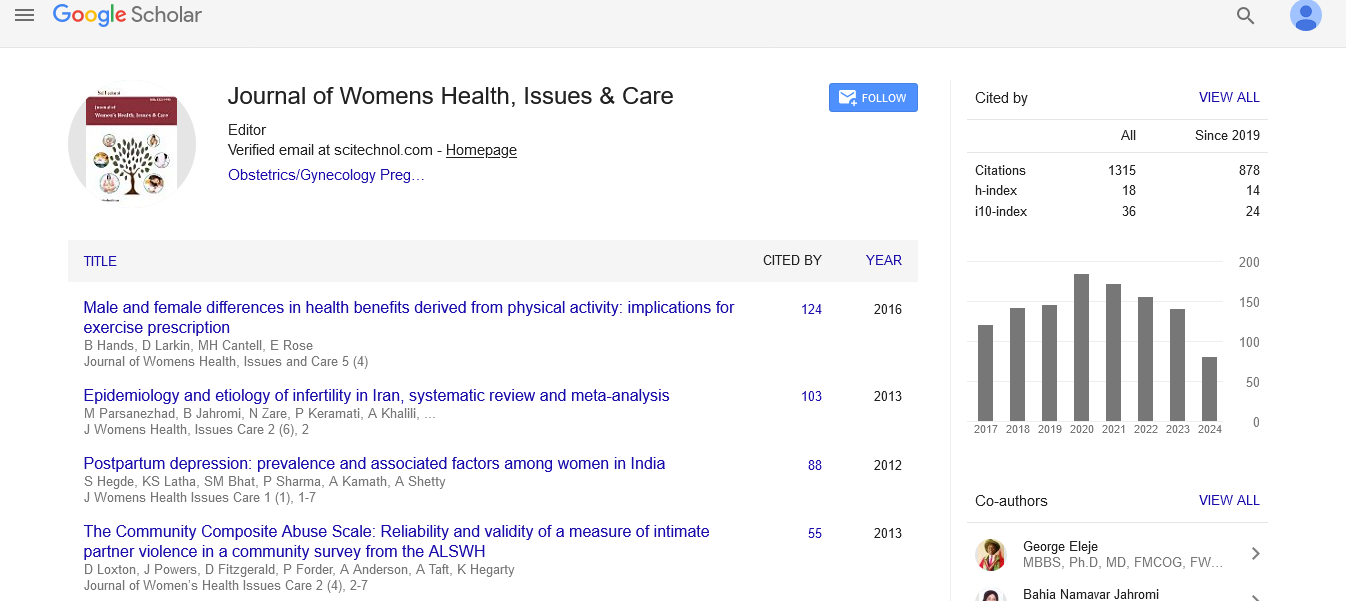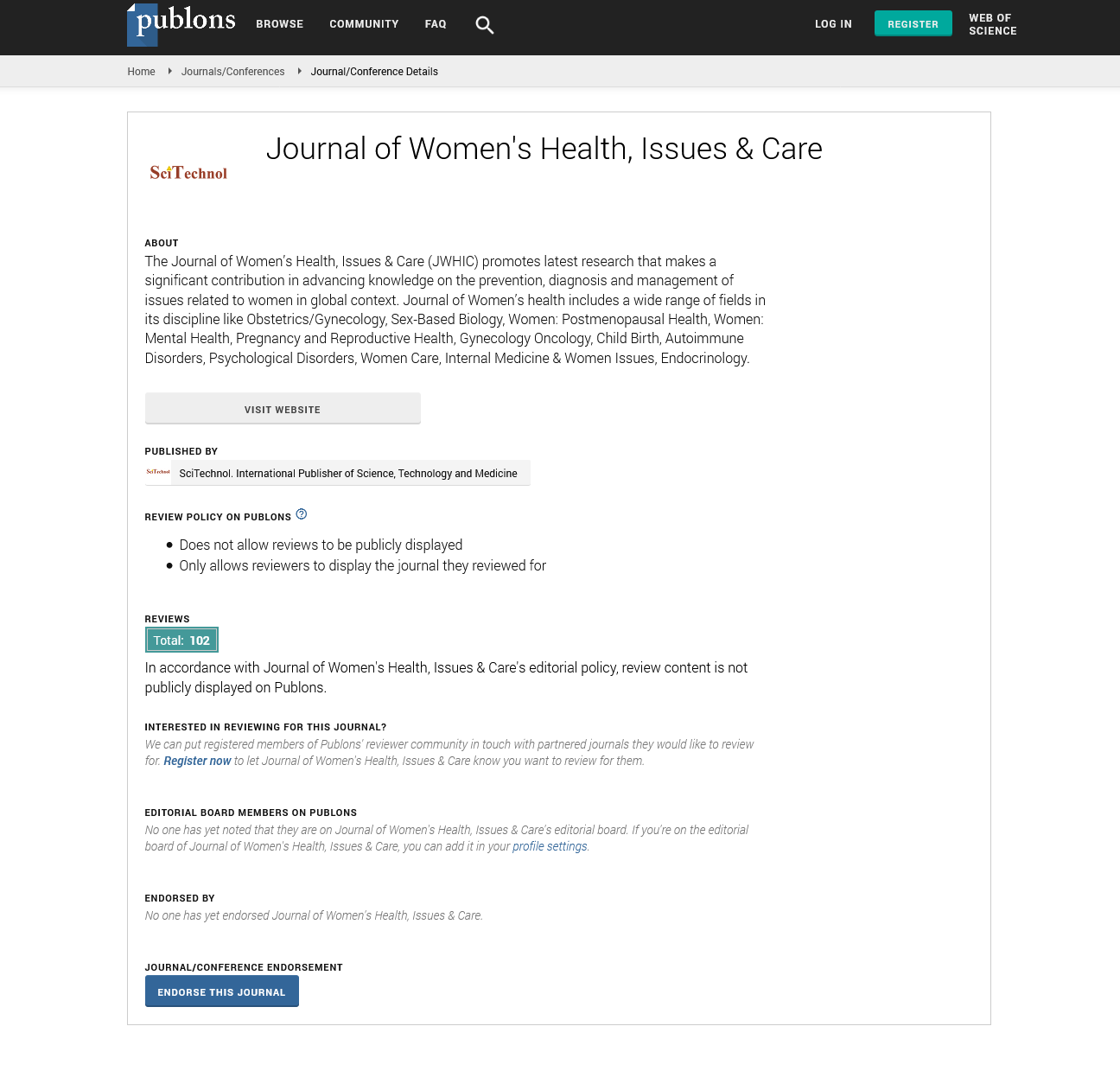Perspective, J Womens Health Vol: 13 Issue: 5
Impact of Menopause on Women's Health: A Comprehensive Overview
Weinjihk Fuo*
1Department of Obstetrics and Gynecology, King Saud University, Riyadh, Saudi Arabia
*Corresponding Author: Weinjihk Fuo,
Department of Obstetrics and Gynecology,
King Saud University, Riyadh, Saudi Arabia
E-mail: weinjih.fuo@gmail.com
Received date: 23 September, 2024, Manuscript No. JWHIC-24-156585;
Editor assigned date: 25 September, 2024, PreQC No. JWHIC-24-156585 (PQ);
Reviewed date: 09 October, 2024, QC No. JWHIC-24-156585;
Revised date: 17 October, 2024, Manuscript No. JWHIC-24-156585 (R);
Published date: 25 October, 2024, DOI: 10.4172/2325-9795.1000524.
Citation: Fuo W (2024) Impact of Menopause on Women's Health: A Comprehensive Overview. J Womens Health 13:5.
Description
Menopause is a natural biological process that marks the end of a women’s menstrual cycles and fertility. It is typically diagnosed after 12 consecutive months without a menstrual period, occurring most commonly between the ages of 45 years and 55 years . However, the age at which menopause occurs can vary significantly among women. Menopause is a normal part of aging and is associated with a decline in the production of the hormones estrogen and progesterone, which play a key role in regulating the menstrual cycle and overall reproductive health. The changes that occur during this time can have wide-reaching implications for a women’s physical and emotional health, affecting everything from bone density to cardiovascular health and even mental well-being.
The process of menopause is typically divided into three stages: Perimenopause, menopause and postmenopause. Perimenopause, which precedes menopause, typically begins in a women’s 40s and can last for several years. During this time, women may experience irregular menstrual cycles, hot flashes, sleep disturbances and mood swings, as the body adjusts to fluctuating hormone levels. Once a woman has gone 12 months without a menstrual period, she is considered to be in menopause. After menopause, the years that follow are referred to as postmenopause, a phase in which women may continue to experience some symptoms, although these usually become less severe over time.
One of the most common and well-known symptoms of menopause is hot flashes. These sudden feelings of heat, often accompanied by sweating and redness of the skin, can last for several minutes and occur throughout the day and night. Hot flashes can disrupt sleep, leading to fatigue and further intensify mood changes and irritability. Night sweats, which are essentially hot flashes that occur during sleep, can lead to poor-quality rest, resulting in feelings of exhaustion and an overall decline in quality of life. In addition to vasomotor symptoms like hot flashes, many women experience changes in their menstrual cycle during perimenopause, which can be erratic and unpredictable. Some women may have heavy periods, while others may experience lighter bleeding. The hormonal fluctuations during this time can also lead to an increased risk of vaginal dryness, which can cause discomfort during interaction and a decline in sexual function.
While the hormonal changes of menopause affect many aspects of a women’s life, they also have significant implications for long-term health. One of the most important consequences of menopause is the increased risk of osteoporosis, a condition in which bones become weak and brittle. Estrogen plays a vital role in maintaining bone density and the decline in estrogen production during menopause accelerates bone loss. This can lead to fractures, particularly in the spine, hips and wrists. Women can reduce their risk of osteoporosis through lifestyle modifications such as regular weight-bearing exercise, adequate calcium and vitamin D intake and, in some cases, medication. Menopause also carries an increased risk of cardiovascular disease. Estrogen helps maintain healthy blood vessels and supports the regulation of cholesterol levels.
Emotional and psychological well-being is another area affected by menopause. Many women experience mood swings, irritability, anxiety and even depression during this time. Hormonal fluctuations can contribute to these changes, but they are also influenced by other factors, such as the physical symptoms of menopause and the stress associated with aging. The transition to menopause may also bring about changes in identity and life circumstances, such as the empty nest syndrome or changes in relationship dynamics, further contributing to emotional distress.
Conclusion
Lifestyle changes, such as regular exercise, maintaining a healthy weight, practicing stress-reduction techniques and getting enough sleep, can also make a significant difference in managing menopausal symptoms. In conclusion, menopause is a natural and inevitable stage of life for all women, but it can come with a range of physical and emotional challenges. Understanding the changes that occur during this time can help women navigate this transition with greater ease and awareness. By prioritizing overall health and well-being, including managing symptoms, adopting a heart-healthy lifestyle and in search of appropriate medical care, women can continue to lead active and fulfilling lives during and after menopause. Through education, support and self-care, women can embrace this phase of life with confidence, knowing that menopause does not define their vitality or sense of self.
 Spanish
Spanish  Chinese
Chinese  Russian
Russian  German
German  French
French  Japanese
Japanese  Portuguese
Portuguese  Hindi
Hindi 



